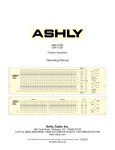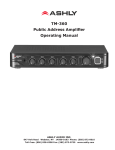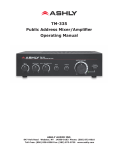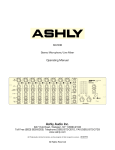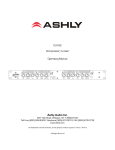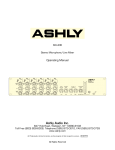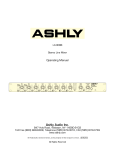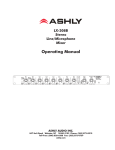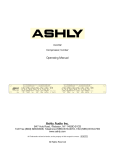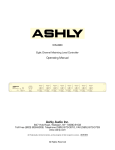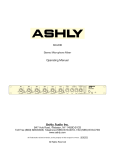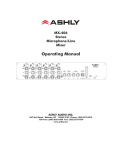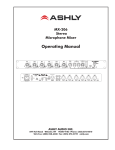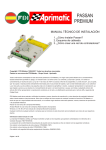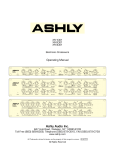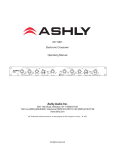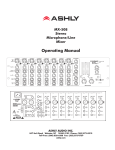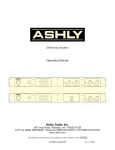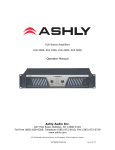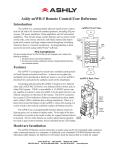Download Ashly PE Series Specifications
Transcript
MQX-2310 MQX-2150 Graphic Equalizers Operating Manual Ashly Audio Inc. 847 Holt Road, Webster, NY 14580-9103 Toll Free (800) 828-6308, Telephone (585) 872-0010, FAX (585) 872-0739 www.ashly.com All Trademarks referred to herein, are the property of their respective owners. R-042707 All Rights Reserved Page - 2 Operator Manual – MQX Series Equalizers This page intentionally left blank Copyright© 2006 – Ashly Audio Inc. Operator Manual – MQX Series Equalizers Page - 3 Important Safety Instructions Consignes de sécurité à lire attentivement Safety Instructions – 3 Introduction - 4 MQX Equalizers – 5 Connectors & Cables – 5 Physical Description - 6 Installation – 7 The lightning flash with arrowhead symbol, within an equilateral triangle, is intended to alert the user to the presence of uninsulated "dangerous voltage" within the product's enclosure that may be of sufficient magnitude to constitute a risk of electric shock to persons. The exclamation point within an equilateral triangle is intended to alert the user to the presence of important operating and maintenance instructions in the literature accompanying the device. 1. 2. 3. 4. 5. 6. 7. 8. 9. 10. 11. 12. 13. 14. 15. Read these instructions. Keep these instructions. Heed all warnings. Follow all instructions. To reduce the risk of fire or electric shock, do not expose this apparatus to rain or moisture. Do not use this apparatus near water. Clean only with dry cloth. Do not block any ventilation openings. Install in accordance with the manufacturer’s instructions. Do not install near any heat sources such as radiators, heat registers, stoves, or other apparatus (including amplifiers) that produce heat. Do not defeat the safety purpose of the polarized or grounding-type plug. A polarized plug has two blades with one wider than the other. A grounding type plug has two blades and a third grounding prong. The wide blade or the third prong are provided for your safety. If the provided plug does not fit into your outlet, consult an electrician for replacement of the obsolete outlet. Protect the power cord from being walked on or pinched particularly at plugs, convenience receptacles, and the point where they exit from the apparatus. Only use attachments/accessories specified by the manufacturer. Use only with the cart, stand, tripod, bracket, or table specified by the manufacturer, or sold with the apparatus. When a cart is used, use caution when moving the cart/apparatus combination to avoid injury from tip-over. Unplug this apparatus during lightning storms or when unused for long periods of time. Refer all servicing to qualified service personnel. Servicing is required when the apparatus has been damaged in any way, such as power-supply cord or plug is damaged, liquid has been spilled or objects have fallen into the apparatus, the apparatus has been exposed to rain or moisture, does not operate normally, or has been dropped. Le symbole de la flèche dans un triangle équilateral symbolisant la foudre est prévu pour sensibiliser l’utilisateur à la présence de tension de voltage non isolée à l’intérieur de l’appareil. Elle pourrait constituer un danger de risque de décharge électrique pour les utilisateurs. Le point d’exclamation dans le triangle équilatérale alerte l’utilisateur de la présence de consignes qu’il doit d’abord consulter avant d’utiliser l’appareil. 1. 2. 3. 4. 5. 6. 7. 8. 9. 10. 11. 12. 13. 14. 15. Lisez ces instructions. Conservez ces instructions. Observez les avertissements. Suivez ces instructions. Pour réduire le risque de feu ou la décharge électrique, ne pas exposer cet appareil pour pleuvoir ou l'humidité. Ne pas utiliser l’appareil près de l’eau. Le nettoyer à l’aide d’un tissus sec. Ne pas bloquer les ouvertures de ventilation, installer selon les consignes du fabricant. Eloigner des sources de chaleur tel: radiateurs, fourneaux ou autres appareils qui produisent de la chaleur. Ne pas modifier ou amputer le système de la mise à terre. Une prise avec mise à terre comprend deux lames dont une plus large ainsi qu’une mise à terre: ne pas la couper ou la modifier. Si la prise murale n’accepte pas la fiche, consulter un électricien pour qu’il remplace la prise désuète. Protéger le cordon de secteur contre tous bris ou pincement qui pourraient l’endommager, soit à la fiche murale ou à l’appareil. N’employer que les accessoires recommandés par le fabricant. N’utiliser qu’avec les systèmes de fixation,chariots, trépied ou autres, approuvés par le fabricant ou vendus avec l’appareil. Débrancher l’appareil lors des orages électriques ou si inutilisé pendant une longue période de temps. Un entretient effectué par un centre de service accrédité est exigé si l’appareil a été endommagé de quelque façon: si il a été exposé à la pluie,, l’humidité ou s’il ne fonctionne pas normalement ou qu’il a été échappé. All Rights Reserved Typical Applications - 8 Troubleshooting - 9 Dimensions - 9 Specifications - 10 Warranty - 11 This manual uses a Perpetual Table Of Contents. Each page has a copy of the manual’s contents in a gray box just like this one. The section you are in will always be bold with the other sections “grayed out.” The feature allows you to jump directly to another section without having to return to a Table Of Contents page. Page - 4 Operator Manual – MQX Series Equalizers Safety Instructions – 3 Introduction - 4 MQX Equalizers – 5 Connectors & Cables – 5 Physical Description - 6 Installation – 7 Typical Applications - 8 Troubleshooting - 9 Dimensions - 9 Specifications - 10 Warranty - 11 Introduction Congratulations on your purchase of an Ashly MQX Equalizer. MQX equalizers offer a low-noise design and wide range of professional features including: Silent In/Out Switching Signal Present and Clip LEDs Precision Wein Bridge Filters 25mm Faders with Center-Off Detent Constant “Q” Design Switchable Low Cut Filter Selectable 15dB or 6dB Range Worldwide Power Supply Balanced XLR, 1/4", and Euroblock Inputs Servo-Balanced XLR, 1/4", and Euroblock Outputs We are confident that you will be pleased with the high performance, superb sound quality, and reliability that Ashly is known for. About Ashly Ashly Audio was founded in 1974 by a group of recording engineers, sound professionals, and electronics designers. The first products were custom consoles for friends and associates, but business quickly grew. The philosophy established from the very beginning holds true today: to offer only the highest quality audio tools at an affordable cost to the professional user – ensuring reliability and long life. More than thirty years later, Ashly remains committed to these principles. Copyright© 2006 – Ashly Audio Inc. Operator Manual – MQX Series Equalizers Page - 5 Safety Instructions – 3 MQX Equalizers Introduction - 4 MQX equalizers use “Q” enhanced Wein bridge filters and interleaved summing for constant “Q”, low ripple, and minimum filter interaction. A servo-balanced output stage simulates a true transformer output to allow interfacing with virtually any type of load. MQX equalizers have with three different connector types: 1/4” inch stereo phone jacks Three pin XLR type connectors Euroblocks These three connectors facilitate interfacing to most professional audio products. Both inputs and outputs can be used balanced or unbalanced. MQX Equalizers – 5 Connectors & Cables – 5 Grounding Physical Description - 6 Installation – 7 Typical Applications - 8 Troubleshooting - 9 Dimensions - 9 Specifications - 10 Warranty - 11 Connectors & Cables Your MQX series equalizer is provided with three different connector types: 1. 1/4 inch stereo phone jacks (TRS) 2. Three pin XLR type connectors 3. Euroblock Connector When possible, balanced connections are recommend between all components in your system, as this eliminates ground-loop induced hum and noise. MQX Connector Polarities Unbalanced Connections and Grounding If you must use unbalanced connectors, the negative lead of the connector should be tied to the ground lead. Using unbalanced connections could result in chassis ground-loop noise. Altering the signal/chassis ground relationship in equipment connected to your MQX unit may eliminate the noise. All Rights Reserved Page - 6 Operator Manual – MQX Series Equalizers Safety Instructions – 3 Introduction - 4 MQX Equalizers – 5 Connectors & Cables – 5 Physical Description - 6 Front Panels Rear Panels Physical Description The MQX-2310 is 2RU, and weighs 11 pounds, while the MQX-2150 is 1RU, and weighs 9 pounds. This manual shows images of both models. MQX-2310 & MQX-2150 Front Panels Installation – 7 Typical Applications - 8 Troubleshooting - 9 Dimensions - 9 Specifications - 10 Warranty - 11 1. 2. 3. 4. Equalization - The individual equalization faders adjust the gain or loss at each filter frequency. There are 31 of these faders per channel on the 2310, and 15 faders per channel on the 1250. By adjusting a combination of faders, an overall frequency response can be developed and the physical position of the faders will give an approximate visual indication of this response. Gain - The gain control adjusts the overall gain of the equalizer when the EQ switch is “in”. It is generally used to compensate for level changes due to the equalization process, but can also adjust overall system level and gain structure. Overall gain with this control is from +6dB to -. Signal Present LED - A green LED indicates when input signal to the equalizer is above 20dBu. EQ or Gain settings have no effect on this indicator, as it only tells you the level of signal applied to the equalizer. Clip Indicator LED - The red Clip LED turns on when any signal within the audio path exceeds +19dBu. Clipping can be detected at the input stage, gain stage, or at the equalizer output. 5. 6. 7. Range Switch - This switch selects the operating range of the individual equalization faders to either ±15dB or ±6dB. The ±15dB settings should be used when much equalization is needed. The ±6dB setting allows finer resolution on the fader settings. EQ In/Out Switch - This switches the Graphic Equalization and gain adjustments, allowing the effect of any equalization to be compared to a “flat” response. This switch does not defeat the High-pass filter. High-Pass Filter - The high-pass filter can be used to supplement the frequency response achieved by the bandpass filters. It’s function is to “roll off” low end response to eliminate subsonic interference like wind noise, floor rumble, and boomy microphone pops. The high-pass frequency on the 31-band models is fixed at 40Hz with an 18dB/octave slope. The MQX-2150 has an internally switched 20Hz high-pass filter which can be disabled by a qualified service technician. Copyright© 2006 – Ashly Audio Inc. Operator Manual – MQX Series Equalizers Page - 7 Safety Instructions – 3 MQX-2310 and MQX-2150 Rear Panels Introduction - 4 MQX Equalizers – 5 Connectors & Cables – 5 Physical Description - 6 Front Panels Rear Panels Installation – 7 General Requirements AC Power Typical Applications - 8 1. Inputs - For unbalanced inputs, the signal should be on the + connection and the connection tied to ground. A mono 1/4” plug used as an unbalanced connection will automatically be grounded. When using a stereo plug, XLR connector, or Euroblock for an unbalanced signal, the (-) input connection MUST be tied to ground. 2. 8. Ashly Servo-Balanced Output - This output circuit is an active output which maintains a constant output level between the (+) and (-) output terminals, regardless of either terminal being connected to ground. This servobalanced output provides an unchanged signal without regard to ground. Power – Switches the unit power on or off. Installation Use four screws and washers when rack mounting the Equalizer. For mobile use, the unit should be further secured as appropriate. General Requirements MQX Equalizers have specific physical, electrical and signal requirements for proper operation. These requirements will vary depending on your specific application, setup, and the settings on the Equalizer. When setting up and testing your system, please take special care to double check all connections and settings. Please refer to the specifications section of this manual for specific input, output and other figures. AC Power Your MQX equalizer should be connected to a standard 3-wire grounded electrical outlet supplying 100-240 Volts, 50-60 Hz. To reduce the risk of ground loop hum, connect all audio equipment to the same electrical power source. Removal of the ground pin is both unlawful and dangerous, as a potential shock hazard could result. This unit will perform normally within the AC voltage range specified above. Voltages less than this, as found in “brown-out” conditions, may reduce performance. In the event of a blown fuse, replace only with same type fuse. No user serviceable parts are inside the chassis. Overall power consumption is less than 25 watts. NOTE: The power switch does NOT isolate the appliance from mains. Make sure the mains power socket or an alternative disconnect device is near by and easily accessible. When the product is connected to mains, the line-filter and the input of the fuse are energized. All Rights Reserved Troubleshooting - 9 Dimensions - 9 Specifications - 10 Warranty - 11 Page - 8 Operator Manual – MQX Series Equalizers Safety Instructions – 3 Introduction - 4 Typical Applications MQX Equalizers – 5 The following information will help you make the most of your new equalizer: Connectors & Cables – 5 General Tone Control Physical Description - 6 Installation – 7 Typical Applications - 8 General Tone Control Feedback Control Console Equalization Room Equalization Troubleshooting - 9 Dimensions - 9 Specifications - 10 Warranty - 11 The graphic equalizer is a very useful device for general tone shaping because it is intuitive and easy to adjust. The visual reference provided by the slider position gives an approximate idea of the frequency response generated, with the lower frequencies on the left and higher frequencies on the right. To use the power of an equalizer effectively, you need to translate your idea of the tone you want to produce into a range of numerical frequencies. This is simple after a little practice. Here are a few references which are useful for starting points: Very low bass (the “wind” in a kick drum, almost felt as much as heard -40Hz80Hz. The low register of a male voice - 200Hz The low register of a female voice - 350Hz Lower midrange (“warmth” frequencies) - 400Hz-1KHz Upper midrange (“harshness”, snare drum “bite”, “hot” sound) -2.5KHz-4KHz. Sibilance (“sss” sounds, cymbal “sizzle”) - 8KHz-15KHz. Try using these starting points as a guide when you want more or less of these types of sounds. Adjust by ear from there. It is always a good idea to remember that a little equalization usually works out much better than a lot, and that there are many audio problems which can not be solved with equalization alone. Feedback Control A graphic equalizer can be used to provide some control over moderate feedback problems, but does not have enough flexibility or resolution to handle severe situations. You will achieve the best results when you can eliminate one or two feedback points by setting one or two sliders for no more than a 6dB cut. Often you can find a feedback point by boosting sliders in succession to determine which frequency ranges contain the feedback modes, and then cutting those ranges. Be very careful in this process to avoid explosive feedback and possible system and hearing damage. If you find feedback points with many equalizer bands, cutting every band may not help (all you will do is reduce system gain). The combination of a graphic equalizer for tone control and a parametric equalizer for feedback control is highly recommended. Console Channel Equalization Many mixing consoles provide only simple equalization for individual channels. If your console has channel inserts, you can patch your graphic equalizer into a channel requiring more precise equalization. Large Room Equalization Large rooms tend to suffer from multiple reflections with long time delays, long reverberation times, and “ringmodes”, all of which lead to reduced intelligibility and a generally “muddy” sound. As sound travels long distances through the air, high frequencies are attenuated more than low frequencies. In general, large rooms benefit from some low frequency roll-off, high frequency boost, and attenuation of ring mode frequencies. As in the case of feedback control, a graphic equalizer can help reduce an isolated ring-mode or two, but a tunable narrow-band equalizer such as a parametric is more effective here. Copyright© 2006 – Ashly Audio Inc. Operator Manual – MQX Series Equalizers Page - 9 Safety Instructions – 3 Troubleshooting Introduction - 4 Situation Action MQX Equalizers – 5 No Audio Output Check AC power - is the power LED on? Check in/out connections - are they reversed? Are you sure you have an input signal? Is the master EQ switch in? The lowest and highest frequency sliders may be beyond the range of the program material or speakers and may produce little, or no audible effect. If the peak light flashes, the signal level to the equalizer is too high, turn down the gain and/or reduce input level to the equalizer. If it is on all the time, disconnect the input and output cables. If it is still on, the unit must be returned for service. This will only be caused by too much signal, which will show on the Clip LED. If the LED is not flashing, there is an overload somewhere else in the signal path. Adjust the relative gain of each component in your chain to keep everything at a comfortable level. Connectors & Cables – 5 EQ Controls Do Nothing Peak Light Flashes or Stays On All the Time Distorted Sound Excessive Hum or Noise Hum will usually be caused by a ground loop between components. Try using the suggested balanced input and output hook-ups if the other pieces of equipment used in conjunction with your equalizer have balanced inputs and outputs. Noise (excessive hiss) can be caused by insufficient drive signal. Make sure you are sending a nominal 0 dBu line level signal to the equalizer. Most noise problems occur because gain is applied to audio signals too late in the chain. For best performance, apply gain to individual source signals as early as possible, like at the mixer input section. As gain increases, it also boosts the noise content of that signal. Any cumulative noise built up in a mixed signal will only be increased by using an equalizer as a gain device, so make every attempt to operate the equalizer with as little gain as possible. Note: Unshielded cables, improperly wired connections, and cable with broken strands (shorts, etc.) are the most common problems. Make sure you use good quality cable with connectors soldered firmly on the correct pin. When in doubt, get in touch with your Ashly dealer. Dimensions All Rights Reserved Physical Description - 6 Installation – 7 Typical Applications - 8 Troubleshooting - 9 Dimensions - 9 Specifications - 10 Warranty - 11 Page - 10 Safety Instructions – 3 Introduction - 4 Operator Manual – MQX Series Equalizers Specifications MQX Equalizers – 5 Specification Input Connectors & Cables – 5 Type Physical Description - 6 Installation – 7 Typical Applications - 8 Troubleshooting - 9 Dimensions - 9 Specifications - 10 Warranty - 11 Impedance Max Level Connectors Output MQX-2310 MQX-2150 Active Balanced Active Balanced 20K 20K +23dBu +23dBu 1/4” Phone Jack (TRS), XLR, Euroblock Servo-Balanced Servo-Balanced Source Impedance 100 100 Min Load Impedance 200 Type Max Level Connectors 200 +23 dBu 1/4” Phone Jack (TRS), XLR, Euroblock +23 dBu Overall 20 Hz - 20 kHz, +/- 0.25 dB 20 Hz - 20 kHz, +/- 0.25 dB THD <.01%@+20dBu <.01%@+20dBu IM Distortion (SMPTE) Output Hum & Noise (unweighted) <.01%@+20dBu -94dBu <.01%@+20dBu -96dBu >85dB @ 1Khz >95dB @ 1Khz - to +6dB - to +6dB Constant Q/Wein Bridge Constant Q/Wein Bridge Frequency Response Channel Separation Gain Control Filters Type Number Bandwidth Tolerance Range Subsonic Filter 2x31 2x15 1/3 Octave 2/3 Octave ±3% ±3% +/-6 dB, +/- 15 dB (switchable) 18dB/Octave @ 40Hz +/-6 dB, +/- 15 dB (switchable) 18dB/Octave @ 20Hz Power Requirements Nominal Voltage Power 100 - 240 VAC (50-60 Hz) 30W Physical Shipping Weight Dimensions 16 lbs 19”Lx3.5”Hx8”D 14 lbs 19”Lx1.75”Hx8”D Copyright© 2006 – Ashly Audio Inc. Operator Manual – MQX Series Equalizers Page - 11 Introduction Safety Instructions -2 –3 Limited Warranty The PE Series Introduction - 4- 3 Warranty service for this unit will be provided by ASHLY AUDIO INC. in accordance with the following warrant statement. ASHLY AUDIO INC. warrants to the owner of this product that this product and the components thereof, will be free from defects in workmanship and materials for a period of FIVE years from the date of purchase. ASHLY AUDIO INC. (ASHLY AUDIO) will, without charge, repair or replace, at its option, defective product or component parts upon prepaid delivery to the factory service department or authorized service center, accompanied by proof of purchase date in the form of a valid sales receipt. This warranty gives you specific legal rights, and you may also have other rights which vary from state to state. EXCLUSIONS: This warranty does not apply in the event of misuse, neglect or as a result of unauthorized alterations or repairs. This warranty is void if the serial number is altered, defaced, or removed. ASHLY AUDIO reserves the right to make changes in design or make additions to or improvements upon this product without any obligation to install the same on products previously manufactured. Any implied warranties which may arise under the operation of State law shall be effective only for FIVE years from the date of purchase of the product. Ashly Audio shall be liable only to correct defects in the product itself, and not for any damage or injury which may result from or be incidental to or a consequence of such defect. Some states do not allow either limitations on how long an implied warranty lasts, or the exclusion or limitation of incidental or consequential damages, so the above limitations or exclusions may not apply to you. Obtaining Warranty Service in the United States For warranty service in the United States, please follow this procedure: Return the product to Ashly, freight prepaid, with a written statement describing the defect and application the product is used in. Ashly Audio will examine the product and perform any necessary service, including replacement of defective parts, at no further cost to you. Ship your product to: Ashly Audio Inc. Attn: Service Department 847 Holt Road Webster, NY 14580-9103 For units purchased outside The United States of America, service will be provided by an authorized distributor of ASHLY AUDIO INC. Obtaining Warranty Service Outside the United States For units purchased outside The United States of America, service will be provided by an authorized distributor of ASHLY AUDIO INC. All Rights Reserved Physical MQX Equalizers Description –5 -4 Installation –&5Cables – 5 Connectors OperationDescription Physical –7 -6 Troubleshooting Installation –7 -8 Spec Table Typical Applications -9 -8 Measurements - -109 Troubleshooting Dimensions - 11 9 Warranty - 12 - 10 Specifications Warranty - 11 Copyright© 2006 – Ashly Audio Inc.













